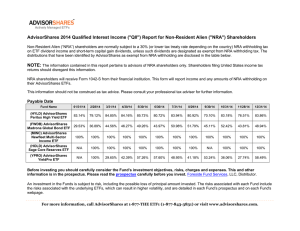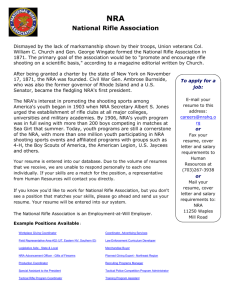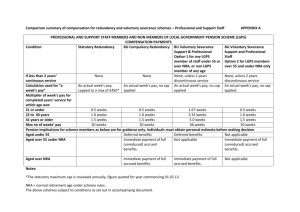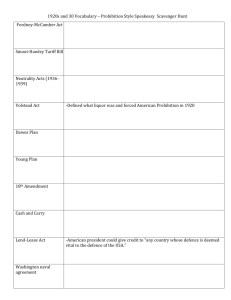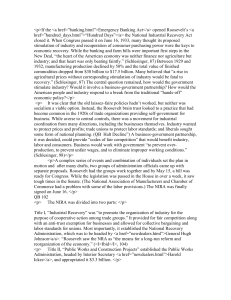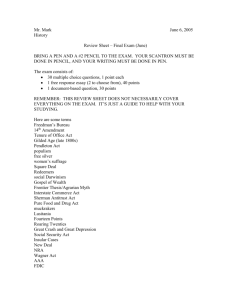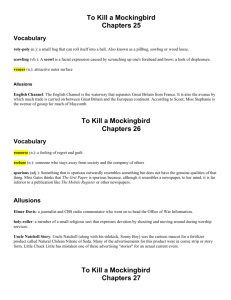Generic Question List
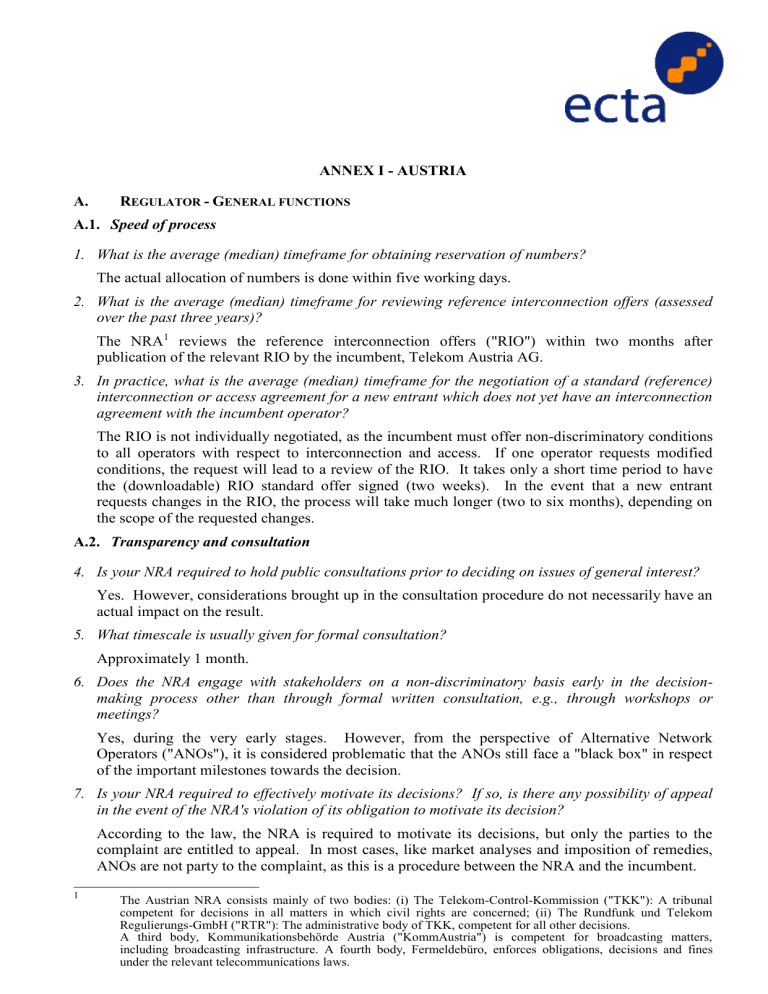
ANNEX I - AUSTRIA
A.
R
EGULATOR
G
ENERAL FUNCTIONS
A.1.
Speed of process
1.
What is the average (median) timeframe for obtaining reservation of numbers?
The actual allocation of numbers is done within five working days.
2.
What is the average (median) timeframe for reviewing reference interconnection offers (assessed over the past three years)?
The NRA
1
reviews the reference interconnection offers ("RIO") within two months after publication of the relevant RIO by the incumbent, Telekom Austria AG.
3.
In practice, what is the average (median) timeframe for the negotiation of a standard (reference) interconnection or access agreement for a new entrant which does not yet have an interconnection agreement with the incumbent operator?
The RIO is not individually negotiated, as the incumbent must offer non-discriminatory conditions to all operators with respect to interconnection and access. If one operator requests modified conditions, the request will lead to a review of the RIO. It takes only a short time period to have the (downloadable) RIO standard offer signed (two weeks). In the event that a new entrant requests changes in the RIO, the process will take much longer (two to six months), depending on the scope of the requested changes.
A.2.
Transparency and consultation
4.
Is your NRA required to hold public consultations prior to deciding on issues of general interest?
Yes. However, considerations brought up in the consultation procedure do not necessarily have an actual impact on the result.
5.
What timescale is usually given for formal consultation?
Approximately 1 month.
6.
Does the NRA engage with stakeholders on a non-discriminatory basis early in the decisionmaking process other than through formal written consultation, e.g., through workshops or meetings?
Yes, during the very early stages. However, from the perspective of Alternative Network
Operators ("ANOs"), it is considered problematic that the ANOs still face a "black box" in respect of the important milestones towards the decision.
7.
Is your NRA required to effectively motivate its decisions? If so, is there any possibility of appeal in the event of the NRA's violation of its obligation to motivate its decision?
According to the law, the NRA is required to motivate its decisions, but only the parties to the complaint are entitled to appeal. In most cases, like market analyses and imposition of remedies,
ANOs are not party to the complaint, as this is a procedure between the NRA and the incumbent.
1
The Austrian NRA consists mainly of two bodies: (i) The Telekom-Control-Kommission ("TKK"): A tribunal competent for decisions in all matters in which civil rights are concerned; (ii) The Rundfunk und Telekom
Regulierungs-GmbH ("RTR"): The administrative body of TKK, competent for all other decisions.
A third body, Kommunikationsbehörde Austria ("KommAustria") is competent for broadcasting matters, including broadcasting infrastructure. A fourth body, Fermeldebüro, enforces obligations, decisions and fines under the relevant telecommunications laws.
8.
Is your NRA required to publish all its decisions upon their adoption?
Yes.
9.
Does your NRA disclose and consult on its action plan on a regular basis?
No.
10.
Are the costs of operating the NRA transparent and available through audited accounts?
No. The ANOs and the incumbents have requested an audit for many years, as they are financing the NRA's operational costs.
A.3.
Powers and sanctions
11.
Are the powers of your NRA clearly defined by law?
The powers of the NRA are defined in the law very broadly by means of a blanket clause
( Generalklausel ). Unfortunately, the NRA has not utilised the powers provided for in this blanket clause in the event of an actual abuse of market power of the incumbent ( e.g.
, in the retention of / relation to carrier pre-selection and call-by-call customers).
12.
Are the NRA’s powers consistent with powers attributed to NRAs in the new regulatory framework? Please answer with reference to any infringement proceedings undertaken by the
European Commission for failure to adequately implement the framework.
The European Commission has initiated first steps in an infringement proceeding against Austria concerning several failures to properly implement the new regulatory framework. Specifically, the
European Commission has alleged violations of Art. 3 (3) of the Framework Directive (impartiality of the NRA), Art. 16 (1) of the Framework Directive (consultation with competition authorities in the context of market definition), and Art. 8 (2) of the Framework Directive (special care towards handicapped users).
13.
Is your NRA entrusted with the power to impose fines? If so, up to what level? Does it include also the possibility of imposing periodic penalty payments or of suspending the commercial launch of services?
Enforcement of regulatory decisions is governed as follows: the NRA is entitled to impose obligations. Actual fines of up to EUR 58,000.00 are imposed by the
Fernmeldebüro
. The competition authority is also entitled to the require payment of the profits corresponding to up to
10 per cent of the relevant yearly turnover, based on a complaint by the NRA, but this has never been applied thus far.
A.4.
Scale of resources
14.
What is the number of employees employed for general regulatory issues (excluding frequency and numbering management)? How many competition economists are included in the staff? How many competition lawyers? What proportion of staff have private sector experience?
NRA: approximately 56 employees for general regulatory issues, plus approximately 14 employees for general support (IT, PR, etc), which is shared with the broadcast unit of the RTR.
The NRA's national economics department: 9 employees, and the NRA's business administration department: 8 employees. No information is available on their experience in the private sector.
15.
Are the procedures for selecting the NRA's personnel fair and open (e.g.
, conducted through a transparent external selection procedure)?
ANOs have no information on the selection procedure. Within the general limits of applicable law, the NRA may determine its own procedures at its discretion. It is generally considered that these procedures are fair and transparent.
- 2 -
16.
Does your NRA have the financial freedom to set levels of remuneration to attract appropriate staff?
Yes.
17.
Can and does your NRA have recourse to outside expertise such as consultants? Is sufficient budget allocated to enable them to do so where necessary?
Yes. The NRA is entitled to hire consultants, although their own staff is deemed to be qualified as expert witnesses by law. NRA rarely makes use of the possibility to recourse to outside expertise.
A.5.
Effectiveness of appeal procedure
18.
Does the appeal of a NRA decision automatically suspend the binding effects of the decision in question?
No. The NRA decision is binding, unless the court of appeal states the contrary.
19.
If the appeal does not automatically suspend the binding effects of the decision of the NRA, what is the applicable standard to obtain such suspension and how is it applied in practice?
Suspension must be applied for in an appeal procedure. In most cases, no suspension is granted.
20.
What percentage of decisions taken since September 2002 were appealed?
From the perspective of an ANO, the overall percentage is difficult to estimate: most of the recent decisions concerned market analyses and the imposition of remedies, which are proceedings in which the ANOs do not participate. Almost all of the remaining NRA decisions ( i.e.
, other than market analyses and remedies) were appealed either by the incumbent, the ANO or both.
21.
What is the average (median) timeframe from the filing of an appeal until the outcome?
Approximately one to three years.
22.
What proportion of court judgements reached since September 2002 resulted in the NRA determination being annulled or overturned?
Approximately 55 per cent.
A.6.
Independence
23.
Is your NRA subject to any injunctions from political authority (other than through removal), when performing its regulatory tasks (e.g., grants authorizations, conducts market analyses, defines
SMP operators, imposes/enforces remedies?)
Legally speaking, no political injunctions are possible. However, political representatives belong to the RTR supervisory board.
24.
What is the duration of office of your NRA's management? Is there a possibility of reappointment?
The RTR managing director is appointed for a term of five years. Re-appointment is possible. All other RTR personnel are employed on the basis of standard employment contracts.
TKK members are appointed for a term of five years, with re-appointment possible as well.
25.
What are the grounds for removal of your NRA's management?
The dismissal of RTR's management is subject to the grounds provided in the relevant provisions of employment and company law.
As regards the TKK, removal can be based on grounds such as membership in a political administration, a close relationship to telecommunication operators, or repeated absence in meetings.
- 3 -
26.
What are the eligibility requirements for your NRA's management?
No specific eligibility requirements are set forth for RTR's management.
The membership criteria for the TKK are as follows: one member must be a judge, one member must have the relevant technical knowledge, and the third member must have the relevant economical and legal knowledge.
27.
Are clear objectives assigned to the NRA for its long term actions set in the law or defined by
NRAs? Are such objectives consistent with the objectives in the Framework Directive?
Yes. In principle, these objectives are identical to those set forth in the Framework Directive.
However, some additional political requirements are mentioned as an objective, due to the special
Austrian focus on some topics.
28.
What percentage of the incumbent share capital is held by the Government? Does it confer control?
The Government holds 30.2 per cent of all shares in Telekom Austria AG through its whollyowned subsidiary Österreichische Industrieholding AG. Such share confers control insofar as any share above 25 per cent provides for certain minority veto rights. Governmental control is diminished insofar as the law allocates the management of the share capital to the Ministry of
Finance and the NRA management to the Ministry of Transportation and Telecommunication.
A.7.
Market analysis procedure and imposition of remedies
29.
Of the 18 markets identified in the Commission’s recommendation, how many SMP analyses have been completed and accepted by the article 7 task force?
15 SMP analyses are complete. However, the following markets are still missing: transit services
(Number 10), wholesale broadband access (Number 12) and wholesale international roaming
(Number 17).
30.
For those analyses where significant market power was found, have remedies been imposed in all cases?
Yes. Where SMP was found, at least one remedy was imposed.
31.
Are market analyses conducted in consultation with the competition agency? Has the analysis been conducted in a rigorous manner following competition law and economic principles as set out in the Commission’s Guidelines on the interpretation of Significant Market Power?
The NRA only asks the competition authority for its input by publishing its draft decision on the
Internet and stating that the national competition authority is given the opportunity to provide a statement during the consultation process. The NRA adheres to the European Commission's
Guidelines on the interpretation of SMP, and the competition authority applies the principles of competition law.
32.
What is the average (median) timescale from the start of the market analysis process to the imposition of remedies where significant market power is found?
12 to 18 months.
B.
R
EGULATORY
D
ISPUTE
S
ETTLEMENT IN
I
NTERCONNECTION AND
A
CCESS
I
SSUES
(A
RT
20
FD)
B.1.
Speed of process
33.
What was, over the past two years, the average (median) timeframe for obtaining a decision from the dispute settlement body?
Six to nine months.
- 4 -
34.
Can your dispute settlement body adopt interim measures prior to final settlement of the dispute?
Yes.
35.
Has the dispute settlement body adopted interim measures in practice, and if so, is this standard practice or only in exceptional circumstances?
No. To our knowledge, the dispute settlement body has not adopted any such measure since the enactment of the Telecommunications Act 2003.
B.2.
Due process
36.
Is the dispute settlement process subject to the principle of contradiction (due process)?
Yes.
37.
What are the possibilities to appeal a decision of the dispute settlement body?
Parties can file a complaint at the administrative court, but only the parties to the dispute are entitled to appeal.
B.3.
Effectiveness of sanctions
38.
Is your dispute settlement body entitled to impose fines or periodic penalty payments? Has it used these powers? Please elaborate.
Yes. Penalties in the event of a breach of contract can be and usually are imposed in the NRA's decision.
39.
Does your dispute settlement body have the power to enforce its own decisions?
No, the decision is deemed to be a civil contract between the dispute parties. Either party can address the civil court with respect to enforcement.
B.4.
Effectiveness of appeal procedure
40.
Does the appeal of a decision of the dispute settlement body automatically suspend the binding effects of the decision in question?
No.
41.
If the appeal does not automatically suspend the binding effects of the decision of the dispute settlement body, what is the applicable standard to obtain such suspension and how is it applied in practice ?
Suspension of the decision is rarely granted.
42.
What percentage of decisions taken since September 2002 were appealed?
There is no statistical data. However, nearly all decisions are challenged by the incumbent or the
ANOs.
43.
What is the average timeframe from the filing of an appeal until the outcome?
Approximately 1 to 3 years.
44.
What proportion of court judgements reached since September 2002 resulted in the NRA determination being annulled or overturned?
Approximately 55%.
- 5 -
C.
G
ENERAL
M
ARKET
A
CCESS
C
ONDITIONS
C.1.
Access obligations (AD article 12)
45.
Does your NRA clearly specify its policy in relation to the obligation to supply access?
No. The NRA does not specify general policy issues; it only decides on a case-by-case basis.
46.
Where access has been mandated, does your NRA typically require (e.g., as part of a stated policy) dominant operators to publish a reference offer for access?
Yes.
47.
Is there a standard procedure available for operators to negotiate access products/services not explicitly provided for in the standard reference offers? In the last 3 cases where such a product was requested, how long did it take for the matter to be resolved and was regulatory intervention necessary?
Yes. The time required to obtain the requested access: two years with regard to wholesale line rental ("WLR"), and one year with regard to wholesale leased line ("WLL"). Please note that the time also depends on the imposed remedies: if the standard offer is imposed as a remedy and is linked to a time limit, then the incumbent complies with the limit and presents the offer to the
NRA. The NRA will check the offer, which can cause further delay ( e.g
., in case of WLL).
48.
Are SLAs commonly available for regulated products? Does your NRA impose on SMP operators obligations in relation to SLAs? Is the effectiveness of SLAs regularly reviewed in light of evolving market demands and changes in the retail offers of SMP operators?
Yes. SLAs are imposed in the NRA decision, and the effectiveness is reviewed whenever the decision is reviewed. Retail SLAs ensure only a rather poor quality, which causes the corresponding wholesale SLAs to be of poor quality as well.
49.
Do SLAs include provision for financial penalties for failure to meet contractual conditions?
Yes.
C.2.
Non discrimination and price squeeze (Art 10 AD)
50.
Is non-discrimination an obligation routinely imposed in markets where one or more operators are found to have SMP?
Yes.
51.
Do non-discrimination requirements apply across the value chain – i.e. between wholesale products as well as between wholesale and retail?
Yes.
52.
Does the NRA have rules in place to guard against price squeeze e.g. a notification or publication requirement for wholesale and retail tariffs which enables the NRA/competitors to verify compliance?
No.
53.
Has your NRA applied price squeeze tests in response to allegations of discrimination? Please provide recent examples.
The NRA started to apply price squeeze tests in the approval procedure of end-user prices. The
ANOs claimed, however, that the NRA's approach was incorrect, as the end user prices are weighted as an average, which means that the actual prices offered on the market can be lower than this average.
- 6 -
54.
Does the NRA have specific provisions to enforce non-discrimination on non-price terms e.g. requirement for transparency of internal contracts, publication of internal SLAs, use of KPIs to identify differences in treatment?
Yes, but the NRA is only insufficiently making use of this.
C.3.
Price control (Art 13 AD)
55.
Does your NRA have a clear policy about how price controls are applied in given circumstances e.g. cost-orientation, retail minus or benchmarks?
Yes. The NRA applies a combination of cost-orientation and retail minus approach.
56.
If cost-orientation is applied, which methodology is used (e.g. historic or current FAC or LRIC)?
Is the methodology clearly specified?
FLRAIC (Forward Looking Longrun Average Incremental Costs), based on an average between a bottom-up (based on NRA calculation) and a top-down (based on incumbent's calculation model).
57.
Is information made available (e.g., number of subscribers, cost allocation between network components, WACC) enabling competitors/third parties to understand cost models and assess regulated operators' compliance with cost orientation?
General information is partially made available, but detailed information is only disclosed to the parties to the procedure. In the case of the mobile termination market, the expert opinion concerning each mobile network operator's costs was distributed to all parties to the procedure.
C.4.
Cost accounting separation (Art 11 AD)
58.
Are SMP operators subject to cost accounting separation obligations? Please indicate the markets in relation to which cost accounting separation is applicable?
The incumbent is subject to a cost accounting obligation for all of its wholesale services. No such obligation has been imposed on the ANOs.
59.
Is the methodology for accounting separation clearly specified and subject to consultation?
No. These details are treated confidentially between the NRA and the incumbent.
60.
Are the accounts drawn in accordance with cost accounting separation published or otherwise made publicly available?
No. These details are treated confidentially between the NRA and the incumbent.
61.
Do the separated accounts clearly show transfer charging arrangements between SMP products and all relevant downstream markets?
No. These details are treated confidentially between the NRA and the incumbent.
C.5.
Rights of way and facility-sharing (Art 11 FD)
62.
Are operators entitled to rights of way on public land?
Yes.
63.
In practice is it possible to exercise these rights in a reasonable timescale and at a reasonable cost?
No. The proceedings take a minimum of three months. There are also uncertainties as to the pricing because there are no guidelines for the compensation of landowners. The authority will decide on a case-by-case basis, depending on the property value loss for private owners. Only public properties are free of charge.
- 7 -
64.
Are there clear rules in place stipulating the procedure and cost?
Yes, but the procedure is difficult and takes too long.
C.6.
Numbering
65.
Is number portability available for fixed numbers? If so, is it available for all types of numbers
(used for fixed services) or is it limited to geographic numbers?
Yes, for all numbers.
66.
Is mobile number portability available?
Yes.
67.
What is the average timeframe and cost for porting numbers for fixed and mobile (if available)?
Fixed: five working days; 21.79 EUR.
Mobile: three working days; 19.00 EUR (incl. VAT) for the customer, EUR 29.00 (excl. VAT) for the recipient operator.
68.
What proportion of fixed and mobile numbers were ported in 2004?
Fixed: 1.3 per cent. Mobile: 0.18 per cent.
69.
Which, if any, number ranges are available to VoIP providers e.g. geographic/special VoIP range?
780 is a special number range for ENUM/VoIP-services; 720 is a number range for non geographic services.
D.
K
EY
A
CCESS
P
RODUCTS OR
R
EGULATORY
T
OOLS BY
A
REA
D.1.
Narrowband voice
70.
What is the level of interconnection tariffs for call termination with interconnection at the local, single and double tandem switch level?
Call setup Tariff/minute peak Tariff/minute off-peak
Local
Regional (single tandem)
National (double tandem)
0
0
0
0.82
1.28
2.25
0.48
0.71
0.87
71.
Are new entrant operators entitled to apply higher charges than the incumbent operator for termination services on their networks? If so, are these tariffs based on an application of the delayed reciprocity principle or can these tariffs be justified on the basis of a cost analysis?
Yes. New entrants are entitled to apply higher charges if they are able to prove higher costs.
Furthermore, only the incumbent offers interconnection services at local tariffs. The ANOs always charge at least a regional (single tandem) tariff.
72.
Is carrier selection and preselection implemented?
Yes.
73.
What is the market share (revenue) of alternative operators in the fixed voice market?
The market share of the incumbent is 55 per cent on the fixed telephony service market, based on minutes. Information on the market share based on revenue is not available. On the access markets, the market share of the incumbent is 95 per cent.
- 8 -
74.
What is the level of interconnection tariffs for call origination at the local, single and double tandem switch level?
Call setup Tariff/minute peak Tariff/minute off-peak
Local
Regional (single tandem)
National (double tandem)
0
0
0
0.82
1.28
2.90
0.48
0.71
1.10
75.
Is wholesale line rental (WLR) implemented? What proportion of active incumbent fixed lines are wholesaled through WLR?
Yes, legally-speaking. However, no operator has accepted the WLR offer of the incumbent, because it is not economically viable.
The prices are set on the basis of retail minus as follows:
Monthly rate per line: EUR 12.70 (excl. VAT). Please note that the cheapest subscription fee offered by the incumbent is EUR 13.32 (excl. VAT).
Implementation fee for every ANO: EUR 750,000.00.
Transfer fee per customer: EUR 36.24.
D.2.
Mobile
76.
What is the peak-rate fixed to mobile termination charge applied by the largest mobile operator in your country?
Peak time Off-peak time Comments
Eurocents per minute
Mobilkom
10.86
Eurocents per minute
Mobilkom
10.86
No peak/off-peak differentiation
A new cost-model sets a glide path for the pricing. Cost orientation is base on LRAIC.
Price adaption will take place in 14 (T-Mobile, Mobilkom,
ONE), 13 (telering), and 12
(H3G) steps until 31 Dec
2011.
77.
Is fixed to mobile termination subject to regulation? Is mobile to mobile termination subject to regulation? If so, please specify the regulatory conditions applied e.g. price control, nondiscrimination.
Yes. Cost-orientation (LRAIC) and non-discrimination are applied.
78.
Where price regulation is applied, are prices required to be cost-oriented? Has a glide-path been applied, and if so, at what date are prices projected to reflect actual costs?
A glide-path has been implemented starting 1 June 2005 and ending 31 December 2011. The current rates are Ct 10.86 (Mobilkom), Ct 13.18 (T-Mobile), Ct 13,80 (ONE), Ct 13.80 (tele.ring) and Ct 19.62 (Hutchison as new entrant). These will be decreased to a final rate, representing the
"costs of an efficient operator". The glide-path (including the final rate) is subject to changes, pursuant to the next market analysis procedure.
- 9 -
79.
Where non-discrimination is applied to fixed to mobile and/or mobile to mobile offnet rates, is the mobile operator required to demonstrate that it is not discriminating with respect to its own
‘internal’ onnet rates?
No.
80.
What are the market shares (by revenues) of the 2 largest mobile operators?
66 %.
81.
What is the price of a basket of average user mobile retail services?
40.10 EUR (10 th
Implementation Report, figure 56).
82.
Is one or more mobile virtual network operator ("MVNO") operational? If so, what is the MVNO market share of mobile revenues (or subscribers)? Is MVNO access subject to regulation?
Yes. However, no market share is available. Only the MVNO interconnection is subject to regulation, not MVNO access as such.
D.3.
Business services
83.
Are there any wholesale partial private line offers ("PPCs") in your country?
Yes.
84.
Are PPCs required to be cost-oriented, and is the cost-orientation principle effectively applied?
Yes.
85.
What are the tariffs offered (connection and rental) for PPCs for 2Mbits/s 2 km?
1,500 EUR (connection charge)
300 EUR/month (rental charge) (10 th Implementation Report, figures 38 and 39).
86.
Are there any specific measures to prevent discrimination in the provision of PPCs and leased lines? e.g. KPIs
No.
87.
Do the leased line wholesale and PPC products include a Service Level Agreement including delivery and restoration times and financial penalties for failure to meet targets?
No.
88.
Are there any restrictions applicable to the migration from leased lines to PPCs?
No.
89.
Is a Wholesale Ethernet Service (WES) available? If not, is it under consideration by the NRA?
Yes.
D.4.
Broadband
90.
Is full local loop unbundling and shared access available?
Yes.
91.
What is the set-up and recurrent tariff charged for both full and shared ULL access?
Shared access Full access
Active loop:
One-off: 54.50
EUR
Per month:
One-off: 109 EUR
Per month: 5.45 EUR
- 10 -
10.90 EUR (same for PSTN and ISDN lines)
The TKK decision Z4/01-11 of 18 June 2001 required Telekom
Austria (TA) to amend its Reference Offer to include line sharing
92.
Are associated facilities such as co-location required to be made available at cost-oriented rates?
Has the NRA intervened to specify the rates and terms for the supply of these services?
Yes. A complaint in respect of the terms and conditions for co-location is pending.
93.
What is the number of unbundled lines as a percentage of total DSL lines?
14% (ECTA Broadband Scorecard, July 2005).
94.
Do contracts for ULL and associated facilities include a SLA including delivery and restoration times and financial penalties for failure to meet targets?
Yes.
95.
What connectivity options (according to ERG classification) are available for ADSL bitstream?
Option 2: available (20%).
Option 3: not available.
Option 4: not available.
96.
What per cent of DSL lines are provided by the SMP operator’s downstream operating retail arm?
80% (ECTA Broadband Scorecard, July 2005).
97.
Do the wholesale broadband products include a Service Level agreement including delivery and restoration times and financial penalties for failure to meet targets?
Yes.
98.
Are there any restrictions on the migration from a resale ADSL offer to a bitstream offer to fully unbundled or shared loops?
No. Telecom Austria AG's offer is considered to be a combination of a resale ADSL and a bitstream offer.
99.
Is a price squeeze test applied by your NRA in relation to wholesale DSL products and LLU?
Does your NRA apply a price squeeze test across the whole value chain e.g. between different wholesale products in addition to between wholesale and retail?
No. The NRA has not yet completed analysis of the broadband market.
- 11 -

